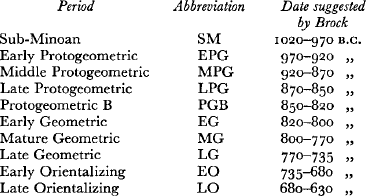Published online by Cambridge University Press: 04 October 2013
The neighbourhood of the Vlychia stream, a little distance to the south-west of the Palace of Minos, has already been noted as an area of settlement in Geometric times. This is now further confirmed by the discovery of a well at about 50 metres north of the stream slightly to the west of the main road to Heraklion; with the exception of a small quantity of stray Middle and Late Minoan sherds in the first 2 metres, the finds ranged from Protogeometric to Early Orientalizing.
The diameter of the well was 0·90 m. At a depth of 1·4 m. began a deposit of Geometric pottery which continued in large quantities down to the sixth metre, mixed with animal bones, pebbles, large stones, brown clayey earth, and a little charcoal. Farther down pottery became rarer and consisted mostly of large coarse wares, while the earth became looser. Between 9 and 10 metres fine pottery virtually ceased, except for small pieces of black cups as 60 and 61 below: much of the space was taken up by the sherds of one enormous coarse basin. Since no fragments of its bottom were found, we may conjecture that it was used as a well-head which either collapsed or was destroyed owing to the drying up of the well. Hence all pottery above the ninth metre is a rubbish fill, which will henceforth be referred to as the Upper Deposit.
2 Archaeological Survey of the Knossos Area (Hood, Smollett, and de Jong) nos. 112 and 107 (traces of Geometric settlement) and 109 (well containing Geometric and Early Orientalizing pottery).
3 The well lies just to the east of op. cit. no. 115, and was excavated by Mr. R. Stopford during the British School's excavations at Knossos in the summer of 1957.
4 It is convenient to adopt here the abbreviations of the chronological divisions suggested by Mr. J. K. Brock [Fortetsa xvi]:

5 The diameter of the rim was about 0·95 m.
6 In the Athenian Agora a rough and ready well-head of similar shape was found in a Late Geometric well (R. 10. 5, unpublished), also a little way from the bottom. I am grateful to Miss Eva Brann for this information.